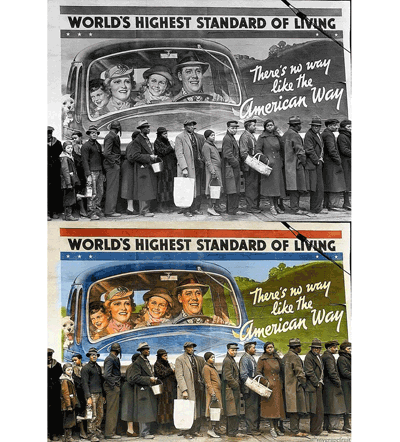
Margaret Bourke-White's 1937 Bread Line during the Louisville Flood. All images colorized by Sanna Dullaway.

This week, Sanna Dullaway’s colorized versions of famous historic photographs went viral on the Internet, drawing both admiration and alarm. Dullaway had picked some truly iconic photographs to colorize, from Dorothea Lange’s Migrant Mother to Eddie Adams’ famous shot of a Vietnamese general executing a Vietcong prisoner during the opening stages of the Tet Offensive. The young Swede (who has just launched a business colorizing old family snapshots) displayed these color versions side-by-side with the originals. Suddenly, figures and scenes long burned into our minds in their original black-and-white incarnations were popping out in glorious color—rusty reds, rich golds, the blue of cornflowers and irises. The images spread quickly on news sites and Facebook feeds—and then some people got mad.
“A parasitical one trick pony grazing on the shoulders of giants,” Dullaway was called in one Facebook photography thread, while someone else excoriated her for “coloring that like a coloring book.” “Sickening” and “inexcusable” were other adjectives thrown out. Some were more generous, admiring Dullaway’s technique and color choices, and writing that it had given them a new appreciation of the original work.
I was intrigued by this response, and by the protectiveness people felt toward these images. Personally I found them fascinating, and not confusing or deceptive since they were printed side-by-side with the original black-and-whites.
(more…)

Photo by Ruvan Wijesooriya

This Thursday the best in Swedish music, art, and innovation comes together in Dumbo, of all places. The Galapagos Art Space will host Sweden Under the Bridge, an intimate acoustic event with performances by Nina Persson (a Cardigans alumna) and Nathan Larson, indie favorite Fibes, Oh Fibes! and up-and-comer Sibille Attar. The concert is in conjunction with a combined exhibition of contemporary photography from Lars Turnbjörk and Ruvan Wijesooriya, a video installation by Roxy Farhat, and digital art by MOCH. Some of Sweden’s famed djs will pick up where the concert leaves off. Entrance is free and an RSVP is necessary.
Slideshow
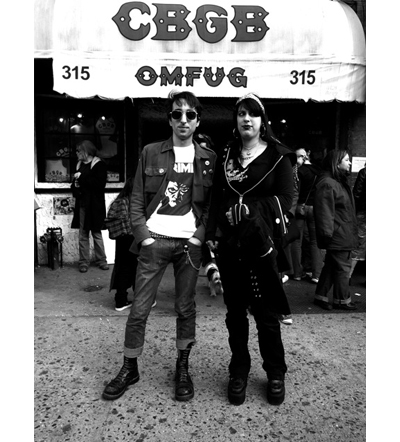
All Photographs by Bruno Hadjadj. COUPLE AT CBGB SILVERPRINT EDITION OF 5

From 1973 to 2006 CBGB was the unofficial home of underground rock in New York City. The seemingly harmless acronym (which erroneously stands for Country, Bluegrass and Blues) was a symbol, the barometer of counterculture, a landmark of irreverence, and the Studio 54 of punk music. More importantly, CBGB set the tone for a new era of rock. The fabled club gave raw, untested bands like the Ramones, Misfits, Patti Smith, The Cramps, Television, Blondie and Talking Heads their start. Initially intended to feature the type of music for which it was named, CBGB became synonymous with the American punk movement and hardcore punk scene instead. Though the club sometimes moonlighted as a record store, or performance space/art gallery, the music always came first. Over the years, CBGB grew its rabidly loyal fan base, became more adept at blurring boundaries and unearthing talent, and changed the current of American punk rock as we know it.
On October 15, 2006, CBGB shuttered its doors for good. Patti Smith, Blondie, Bad Brains, and The Dictators were among some of the last performers to grace the stage, leaving hordes of fans, journalists, and musicians with something to blog about for years to come.
Slideshow
(more…)
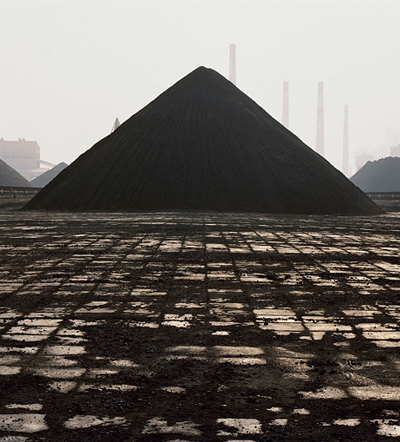
Bao Steel #8, Shanghai , 2005 Edward Burtynsky Photography

Think of the seven manmade wonders of the world, the list that originally included the Hanging Gardens of Babylon and the Colossus of Rhodes. Each creation was magnificent in its own way – each a monument to the uniquely human capacity we have to alter the land around us at an astonishing scale.
Now consider the photographs of Edward Burtynsky and the entirely different form of sweeping change they document. Whereas the pyramids at Giza are a celebrated symbol of the engineering feats of an ancient era, Burtynsky shows us the large-scale constructions of today, like the mounds of coal that power China’s Bao Steel factory outside of Shanghai. In contrast to those earlier pyramids, there’s a less exalted feeling conveyed by the sooty heaps that feed the burgeoning Chinese city’s relentless appetite for construction materials. The picture casts some doubt on the glory of our achievements, given the ecological price revealed. Yet the impact of such a representation is likely more complex.
The photographer tells
PLANET that the motivation behind his work is in large part to shed new light on our perceptions of the ever-changing places we inhabit: “I’m interested in how the medium of photography can help us see the world anew – to take the perceived ‘mundane world’ and move it into forms that challenge conventional notions of our world and landscape,” he says.
Slideshow
(more…)
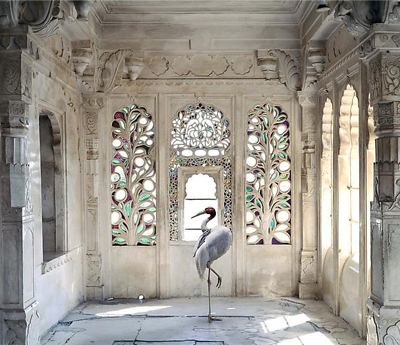
All Images by Karen Knorr. A PLACE LIKE AMRAVATI. UDAIPUR CITY PALACE.


Karen Knorr has built a career out of examining our most opulent places: châteax, English gentlemen’s clubs, grand museums, and her own lavish childhood home. Knorr details the beauty of the finest architecture and ornament, but luxuriating in the grandeur isn’t the point. Knorr fills her rooms with occupants that belie the established respectability and dominance of such seats of power. Tweed-clad men representing the English landed gentry stand idle on their rolling grounds, at a loss amidst so much wilderness. A naked woman lounges on a museum floor, daring tourists to find her naked body obscene among its million painted counterparts. Lately, Knorr has been using animals as the unlikely inhabitants of castles and academies. Using a time-consuming digital process she calls “photoweaving,” Knorr slips giraffes and leopards into the elite’s most carefully molded, supposedly controlled interiors, rendering centuries-old monuments to human hierarchy instantly ephemeral. Though her work was initially grounded in her European roots, she carries her concerns overseas in her latest series, India Song. Knorr spoke with us from outside of Hampi, in southwest India.
Slideshow
(more…)

Doug Rickard #41.779976, Chicago, IL. 2007, 2011 © Doug Rickard, Courtesy Yossi Milo Gallery, New York


Creating a benchmark in the history of documentary photography, Doug Rickard uncovers marginalized sections of the U.S. where promises of the American dream have ended as mere illusion. Appropriately titled A New American Picture, the captivating images reproduced from Google Maps’ Street View portray the lives of Americans in which unemployment is excruciatingly high and the standard of living is shockingly low. Beyond its initial function of mapping America, Google Maps inadvertently reveals the dire situation of the 99%.
A stark contrast to Robert Frank’s lonesome yet bustling America in the late 1950’s, the figures in Rickard’s work are in destitute conditions. You won’t find the young and the beautiful smoking cigarettes or couples cuddling in slick Buicks on these streets. Since Frank documented the country post-World War II, photographers have traveled the nation to preserve its idiosyncrasies. Rickard, on the other hand, documents the nation’s most underprivileged areas from the comfort of his own home. Carefully choosing angles on Street View, Rickard composed all images by photographing his computer screen with a digital SLR camera. Inevitably, Rickard’s work raises issues on surveillance, privacy, and the increasingly intrusive world the advancement of technology has created. This discussion, just like the use of Street View for art, has organically surfaced beyond Rickard’s original intention. With these fascinating images, Rickard has changed the history of documenting America and simultaneously captured the zeitgeist of our nation today.
Slideshow
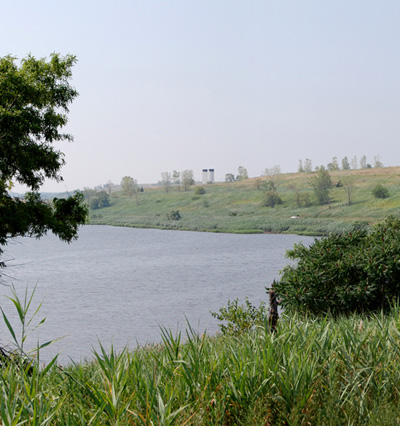


If Fresh Kills sounds like a less-than-picturesque place to visit, that may have something to do with a misreading of the Middle Dutch word “kille” as denoting something sinister, when in fact it refers innocently enough to a body of water. It’s the same negative association that once compelled PETA to suggest replacing the town of Fishkill, NY’s vaguely piscivorous name with the more peaceful-sounding Fishsave. And yet, in the case of Fresh Kills, any disagreeable images the name may conjure have been completely accurate for much of the past six decades. If you hear “Fresh Kills” and think “a pile of hollowed-out chicken carcasses newly delivered from Chinatown,” you’re pretty much spot on.
Next year, the Land Art Generator Initiative (LAGI) arrives on New York City’s Staten Island, with the goal of turning a small portion of the 2,200-acre former landfill called Fresh Kills (at one time the world’s largest) into two things it hasn’t been in recent history: aesthetically pleasing and a source of cleanliness. The site was closed to waste disposal in early 2001, although briefly reopened to receive the remains of the World Trade Center after the 9/11 attacks. Now that the New York City Department of Parks & Recreation is engaged in a 30-year project to transform the land into a park three times larger than Central Park, LAGI’s organizers plan to add their own contribution to the repurposing of the dumping grounds with a piece of public artwork that generates renewable energy.
(more…)
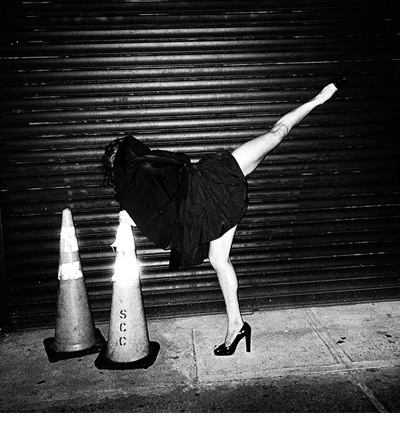

Transplant New Yorker Christopher Bush started photography through a short-lived love affair with physics and astronomy. Since then he has created a seductive body of work featuring raw imagery of some of the most exciting faces gracing the fashion today. Devoted to the process of analog photography, Christopher tells us he feels it’s a necessity for a photograph to exist physically. “Good photographs are not made in your head — not even fashion ones,” he says. Inspired by music, nighttime, and tension, his work reminds us what an exciting city New York still is.
Slideshow
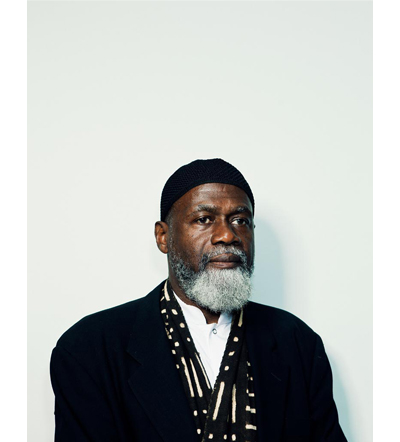
Imam Abdul by João Canziani

For photographer João Canziani, documenting Occupy Wall Street goes beyond photographing protestors. His NinetyNine Portraits, taken over the course of two days in October before Zuccotti Park was forcibly cleared by the police, is a depiction of the phenomenon of Occupy rather than the demonstration. Canziani’s camera moves fluidly between campers, the tourists who gawk at them, the cops who surround them, and the bankers who pass them twice a day. This is the real 99%, a microcosm that didn’t self-select. The portraits are vividly lit and often disarmingly candid, but they come with no identifying label or context. Whatever you guess about the subjects comes from their faces, not their slogans.
How is Ninetynine Portraits different from your previous work?
I usually don’t get very political. My personal has often been “personal.” As in something I want to learn more about myself, my family, or the places I grew up in. And I’m also a contrarian at heart, so I strive to not do what I feel everybody else is doing. But in this case I felt I had a viewpoint that was different from everybody else’s, and something that was new to me.
Slideshow
(more…)
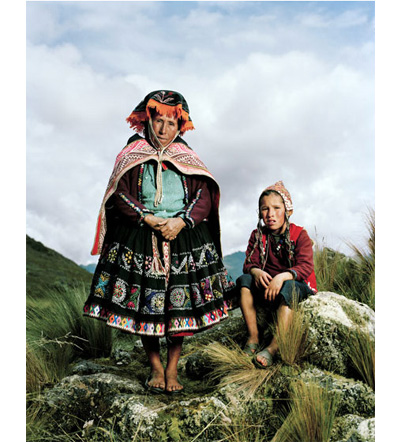
All photographs by Mathias Braschler and Monika Fischer, courtesy of Hatje Cantz. Juliana Pacco Pacco, llama herdswoman. Paru Paru, Peru.

Climate change is notoriously difficult to illustrate. Shifts in sea level, soil acidity, and air composition occur slowly and over such long periods of time that they can’t grab headlines the way more dramatic, photographable events like wars, debates and protests do. Photographers Mathias Braschler and Monika Fischer have brought the issue to the forefront by documenting men and women in rural communities around the world whose way of life has been unravelled by climate change. Their book of portraits and interviews, The Human Face of Climate Change, is a powerful political document, giving an inescapable, emotional face to the issue.
The color photographs of these men and women are vivid, but what’s more powerful is their personal testimony. Each one has made a brief, page-long statement, that’s been translated into English in simple, declarative sentences that emphasize the gravity of what they’ve seen. All have observed climate change in their own communities and in their own lifetimes, over a span of just ten or twenty years. And all of them – in the Americas, Africa, and Asia — have the same stories to tell: their bodies of water are shrinking, their shorelines are eroding, their glaciers are melting, and their soils are becoming less fertile. Some of the evidence is tragic.
Slideshow
(more…)





 Facebook
Facebook Permalink
Permalink Digg
Digg Reddit
Reddit LinkedIn
LinkedIn StumbleUpon
StumbleUpon Tumblr
Tumblr













